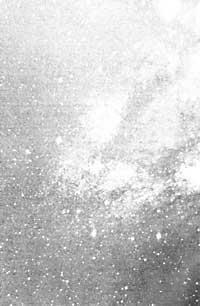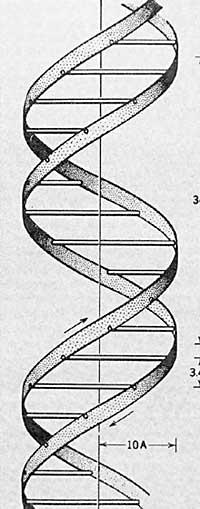Are the bases of biochemistry extended in interstellar space?

As we have seen, astronomers are optimistic about the problem of the discovery of new solar systems. This optimism gives rise to another question: how can we answer the question that life exists in other parts of the Universe?
Within the framework of our solar system the negative response is sufficiently grounded. When the Viking space villas headed to Mars to find traces of life, it was known that the environmental conditions of other planets (temperature, absence of atmosphere or composition of atmospheric inclemencies, ...) would not allow a living development as we know it. The results of Martitz's study were also negative.
The two Viking spacecraft landed on the red planet in the summer of 1976 and carried out three experiments to find life: first, measuring the composition of the atmosphere, then measuring the amount of organic compounds and finally, a series of experiments to find living microorganisms. In the first session no traces of water vapor were found in the atmosphere and we know what it means for the survival of life. The presence of organic compounds is also minimal, less than a part per billion. This amount is lower than that which should have been due to the contribution of fallen meteorites.
This indicates that organic compounds have been destroyed, probably by solar ultraviolet radiation. The department of detection of the metabolic activity of microorganisms has left some doubts. The experiments showed some chemical changes, but since it cannot be seen that they are biochemical processes, neither can it be said that they are not biochemical. However, most scientists, as we have said, consider that life does not exist. But on this occasion we do not want to stay within the limits of the system and we speak of the possibility of finding life around other stars.
When analyzing this problem, it is usual to perform a probabilistic calculation of the number of living planets similar to those of our galaxy, using variables such as: N, the number of stars in our galaxy; P, the probability that a star will have planets; P f, the probability that there will be a planet in each system that meets the physical conditions for the development of life; P b, the probability of developing life on a planet; D, the time that life can remain on the planet and T, the age of the galaxy. Since each probability conditions the following, the calculation would be done by the following expression:
P = N . P . P f . P b D/T
Although it seems like a simple and beautiful formula, it has no great use because most of these magnitudes are very incalculable. That is why there are formulas of this type that say that in a very small place they keep a great darkness. The biggest problem that raises us to make estimates is that we only know a planet with life, the Earth. Therefore, it is impossible to obtain accurate and reliable calculations. Therefore, we must open new paths. That's been F. Hoyle and his assistant N.C. What Wickramasinghe has done. We will now comment on his theory about the origin of life.
We will begin by analyzing a little the development context of the theory. Evolutionism is the basis of modern biology. But we will take evolutionism in a broad sense. Not only taking into account the evolution of species – Darwinian evolution, but also the prebiotic evolution that led from the inorganic substances to the formation of living beings. I.S.O. For the first time Haldane and A.I. Hoyle's theory arises from this prebiotic evolution proposed by Oparin. In his opinion this stage did not take place completely on Earth. In space there are a lot of compounds necessary for the development of life and evolution on Earth after its fall.

If this were so, we should relate the origin of life to phenomena of another order, such as the evolution of stars and interstellar dust. The problem of the existence of more planetary systems like ours, we would relate it to the birth and evolution of stars. This hypothesis does not contradict S.L. Experiments similar to Miller's primitive broth, as one can think of a principle. Primitive broth experiments do not show that these processes occurred on Earth, but could occur.
Therefore, if the new alternative we now present was acceptable, we should assume that the processes described by Miller occurred elsewhere. In addition, with this theory of Hoyle we overcome one of the most important objects made to Haldane-Oparin: the brevity of the process of creating life. If the Earth was established 4,500 million years ago, only one million years ago it became the first complex organisms. This is a very short time to pass from simple inorganic molecules to living beings.
In the previous paragraph we explained the core of Hoyle's theory, but we have not yet analysed the experimental data behind these ideas. Before performing this analysis, a small information will be provided on the relevant compounds that make life possible to carry out a more detailed assessment of them.
Three groups of organic compounds are necessary for the development of life: amino acids, nitrogenous bases and porphyrin. Together with these, it is worth mentioning a very important process: polymerization. Through this process two identical or similar molecules are joined by losing a water molecule. As can be seen in diagram 1, amino acid polymers form long chains called proteins. Proteins appear in all living beings and perform very diverse and specialized functions.
For example, hemoglobin takes oxygen for subsequent administration to tissues. Nitrogenous bases can be joined with a group of phosphates (P) and sugars called ribose or deoxyribose by the administration of ribonucleotides (RN) and deoxyribonucleotides (DN) respectively. The polymerization of RN provides ribonucleic acid (RNA), which allows the formation of proteins like those lost by living things. DN polymerization provides deoxyribonucleic acid (DNA) that achieves the reconstruction of molecules identical to RNA and itself. Therefore, this ensures one of the most specific peculiarities of living beings: reproduction. (See diagram 1).
Finally we mention porphyrins. One of them is the basic component of the chlorophyll molecule, and in it resides its importance, since chlorophyll is essential for the existence of life. It participates in the formation of glucose molecules, according to the third reaction of scheme 1 that takes place in the plants. Then the glucose molecules form the long chains of the family of polysaccharides (starch and cellulose), from which living beings obtain energy to carry out their activity. That is why they are so important.
Let's analyze the experimental tests we mentioned before. As the theory says that the fundamentals of life come from space, we have to go and look for the basic compounds. In particular, we will find them in interstellar matter and meteorites.
Izarra clouds are formed by gas (97%) and dust (3%). Of course, the most abundant component is hydrogen, which is in a gaseous state of one of the three following forms: atomic hydrogen neutral, ionized hydrogen or molecular hydrogen. But in addition to hydrogen, many other substances have been found in a gaseous state, analyzing the emission of interstellar clouds in all bands of the spectrum.
Among them there are many simple inorganic and organic compounds, but also others that may be related to our subject and that are quite complicated. For example, hydrocyanic acid (HCN), formaldehyde (H 2 CO), ethanol (C 2 H 5 OH), methylamine (CH 3 CH 2 H), isocianic acid (HNCO), cyanamide (H2NCN), acetaldehyde (Hcn), Church (3), etc. And formaldehydes and methyl amine can react to manage glycine, one of the essential amino acids.
As for the composition of dust, Hoyle and his collaborators consider that organic compounds have a great importance. The composition models must respond to very specific conditions. On the one hand, this powder has a fairly large side for visible light. On the other hand, the amount of radiation that absorbs dust increases with the inverse of the wavelength, but presents a decrease in absorption (a relative minimum) for a length of 2200 and finally polarizes the light.
Initially it was thought of a mixture of graffiti, inorganic ice, organic polymer and silicate, which did not respond to the emission and absorption spectra studied. The need to deal with new substances led to the investigation of cellulose and, although no one thought, this polysaccharide was the one that best adjusted to the spectrum. This means that a high percentage of dust is formed by polysaccharides. In addition, it has been shown that the absorption spectrum of some stars can be explained by the existence of compounds formed by carbon and nitrogen rings. Among them, several porphyrins could be found.
Let us now see the contribution of the meteorite study. Among the meteorites, the ones that interest us most are the so called condrites with carbon. In some of them, the presence of amino acids, some necessary for life and other non-existent on Earth, has been proven.
For all this, it is difficult not to recognize that the bases of life have been developed on Earth and in space. If this is so, it is logical to think that these posts fell to Earth in the last phases of the formation of the Solar System for later evolution. And, therefore, we must recognize that in the configuration of other planetary systems the same could occur. This also affects the estimation of the probability P b of the formula initially mentioned.
Buletina
Bidali zure helbide elektronikoa eta jaso asteroko buletina zure sarrera-ontzian












